
I’m Koro, a curious blogger in a wheelchair, and I’m the Director of Design and Systems at DisabilityLog. I love cute things, Disney, and fashion. I’m also interested in digital art and NFT!
I myself was born with a physical disability and have been operated on and hospitalized many times. I have spent more time than most people facing rehabilitation. For a time, I was even hospitalized for a long time and transferred to a school with a rehabilitation center. During that time, I was supported by so many people, including doctors and nurses working at the hospital, physical and occupational therapists, and teachers at the special needs school. At that time, I thought that rehabilitation was something that had to be done face-to-face.
But now, you can watch videos and do stretching and other exercises by yourself at home whenever you want, without having to be in contact with other people. Due to the new coronavirus, going to the hospital increases the risk of infection. An application that can also help reduce the risk of going out is exactly what we need in this day and age.
Therefore, I would like to introduce in detail the rehabilitation application “IERIHA”, which allows me, a wheelchair user, to do simple rehabilitation while sitting in a chair, based on my experience.
Enjoy Rehabilitation at Home
What is IERIHA?
This is an application that allows you to do rehabilitation while sitting at home for free.
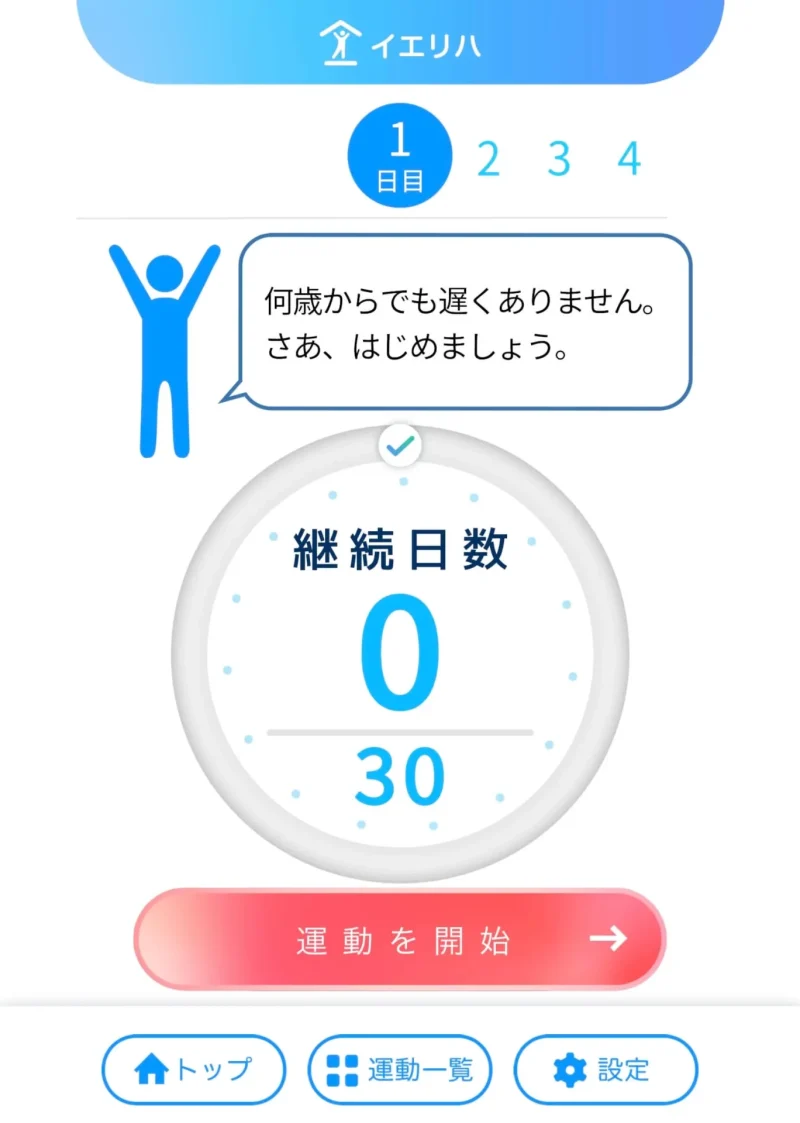
The following is a quote from IERIHA’s detailed information.
Rehabilitation is very important to prevent bedridden patients and to improve conditions requiring nursing care.
Many people receive rehabilitation at places such as day care centers and day services. However, rehabilitation at such places alone may not be sufficient, and if there is an outbreak of infectious diseases in the community, people may not be able to attend the rehabilitation sessions or may not want to participate in them.
This application introduces rehabilitation methods such as exercise, daily movement training, nutrition, and oral care in order to help elderly people who need care or who want to practice care prevention to continue rehabilitation at home. We also make it easy for them to see how they are doing every day so that they can make rehabilitation a habit.
The application was developed jointly by specialists from various fields to propose specific rehabilitation methods, such as what kind of exercise to pay attention to, how to train daily living activities, and what to pay attention to in terms of nutrition and oral care.
This application was produced by the Hiroshima Prefecture Association for Chronic Care Medicine and the Laboratory of Mental Function Control Science, Hiroshima University Graduate School of Social Medicine for Symbiosis, under the 2021 Hiroshima Prefecture Comprehensive Project for Ensuring Regional Medical Care.
Features of IERIHA
- Specific rehabilitation suggestions for exercise, activities of daily living, oral care, and nutrition
- Explanations of rehabilitation methods that can be done effectively and safely at home, selected by experts in each field.
- Visualization of rehabilitation methods with images and videos
- Attachment of various materials on nutrition, food, etc.
- Select and record the rehabilitation methods to be performed daily.
Impressions of people with disabilities/persons with disabilities who have tried IERIHA
My impression of the program is that it was revolutionary in that I could do it while sitting at home. I liked that I could choose the rehabilitation I wanted to do at my own pace. With the animated explanations, it was easier to visualize than following text or illustrations, and the app allowed me to experience an unprecedented experience.
At first, it took me 30 minutes to go through the entire rehabilitation menu I had set up for myself. As I get used to it, I may gradually learn the contents of rehabilitation and be able to do it faster, but I would like to work on it steadily when I have time to spare.
While having fun, I can see how hard I am working each day, which motivates me and brings me closer to a healthier body. To take such a step forward, I wanted to continue rehabilitation at home on an ongoing basis.
If I were to do a review, I would rate it 5 stars.。
I thought it would be even better if there was a video compilation with audio commentary on YouTube.
I have heard that there are several other rehab apps that are available, and I would like to try those as well from time to time. If there is an app that allows me to exercise in my sleep, I would like to try it…
How to download the “IERIHA” app (iPad/iPhone)
To download the application, please search for “IERIHA” or use the link below.
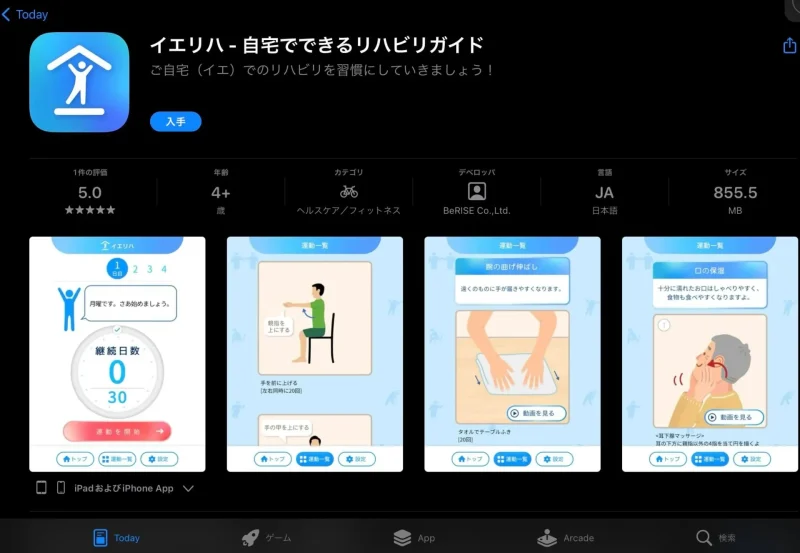
For the App Store:

Get ⇒ Install ⇒ Open ⇒ Launch the application
In the above order, your app is set up!
Installing on an iPad is recommended because the screen is large and easy to read.
Starting in the next section, we will explain how to use the actual IELIHA application.
The display orientation of the application will automatically be portrait orientation.
How to use IERIHA
initialization
(1) I agree (*Please read the precautions carefully)
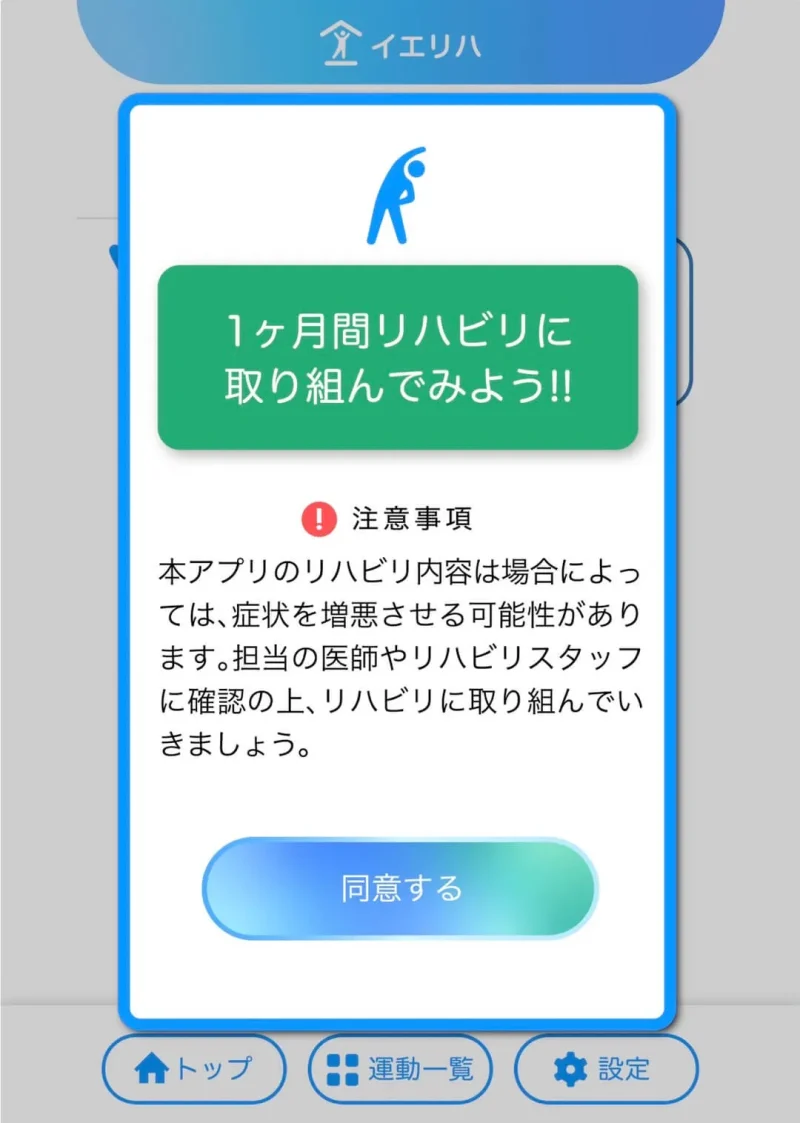
(2) Next
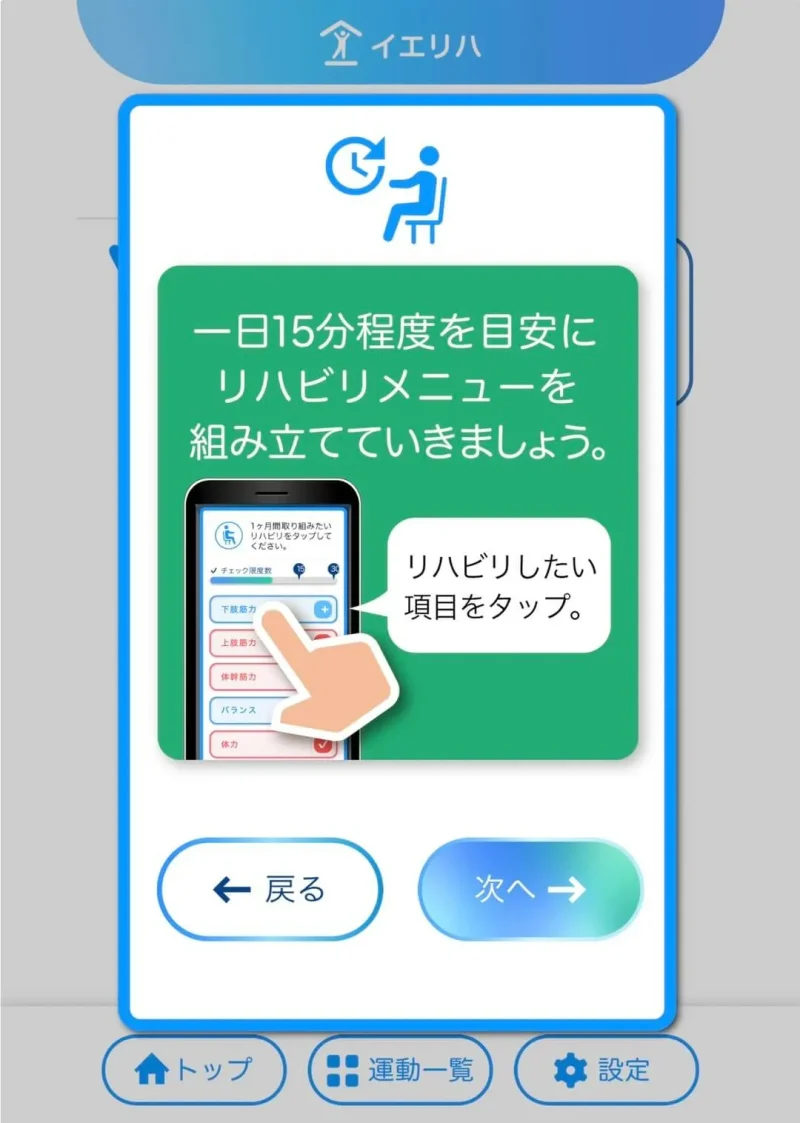
(3) Start
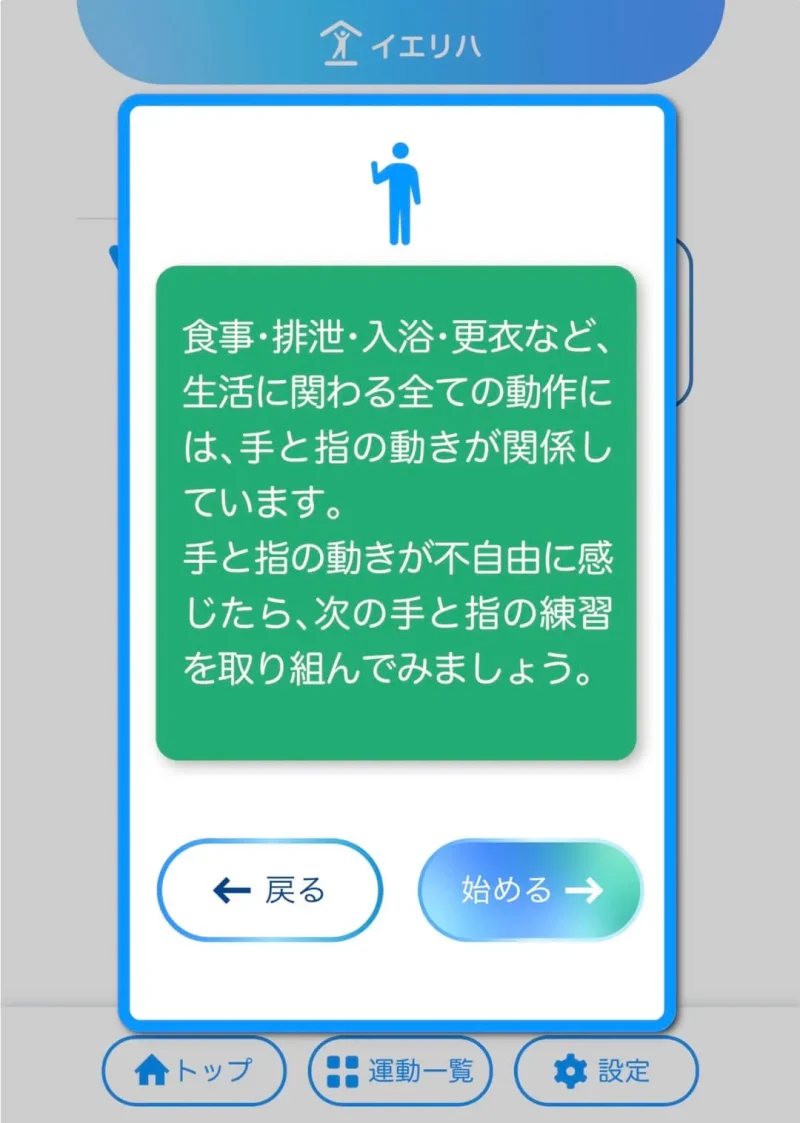
Register for Rehab
Tap to select the rehabilitation program you wish to work on for one month.
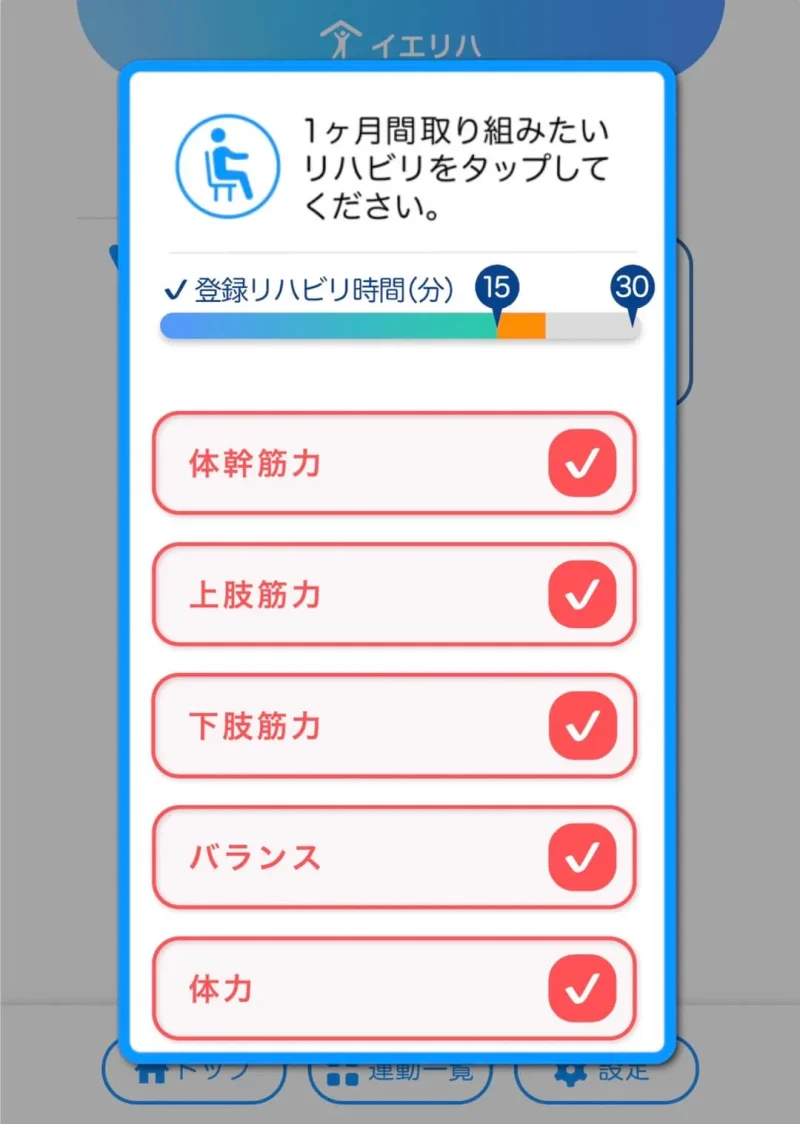
*Changes in rehabilitation can be made afterwards.
(There is a button “Change registered rehab” in the settings.)
15 to 30 minutes is recommended.
If the total registered rehabilitation time exceeds 30 minutes, no further rehabilitation can be selected.
Let the exercise begin!
From the top, press the “Start Exercise” button to begin rehab!
Some of them are quite difficult, so try to do as much as you can without overdoing it.
To move on to the next rehab, scroll to the bottom and press “Go to Next Rehab” or “Close”.
After all the day’s rehabilitation is completed, score today’s rehabilitation fulfillment.
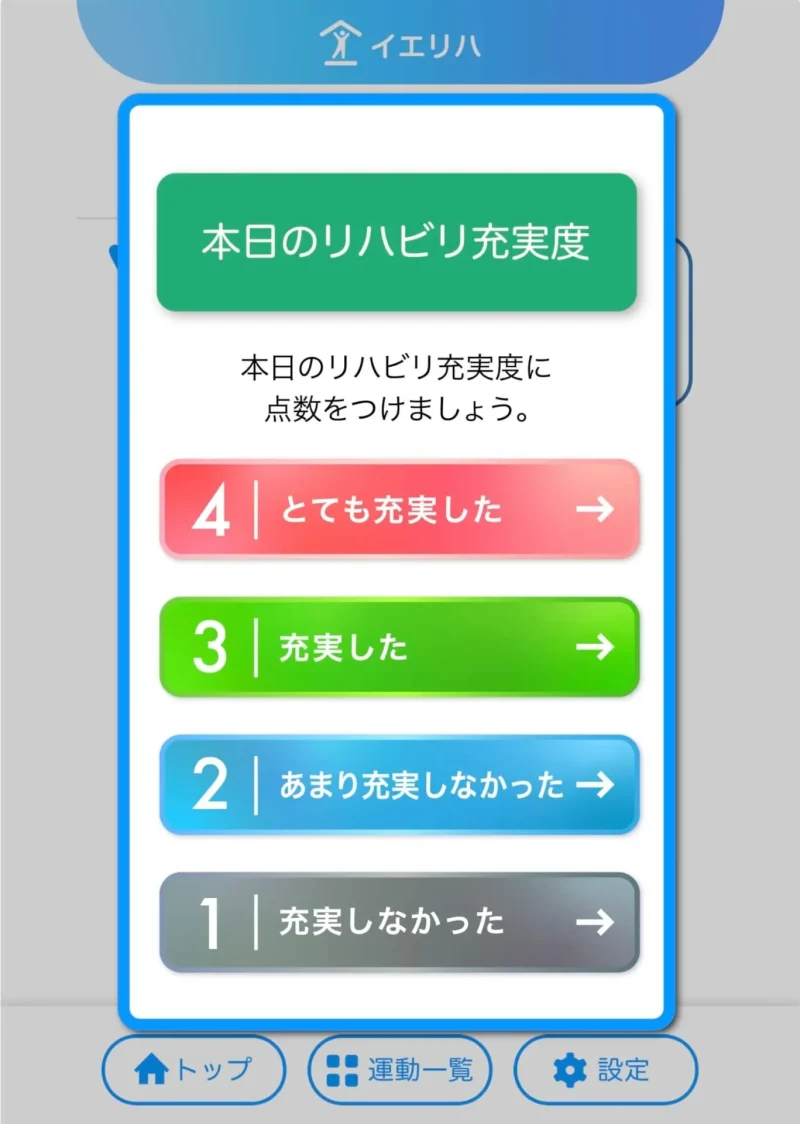
A message about nutritional information will then pop up.

Once confirmed, it is closed and the day’s rehabilitation is complete.
Continuous for 30 days (1 month)
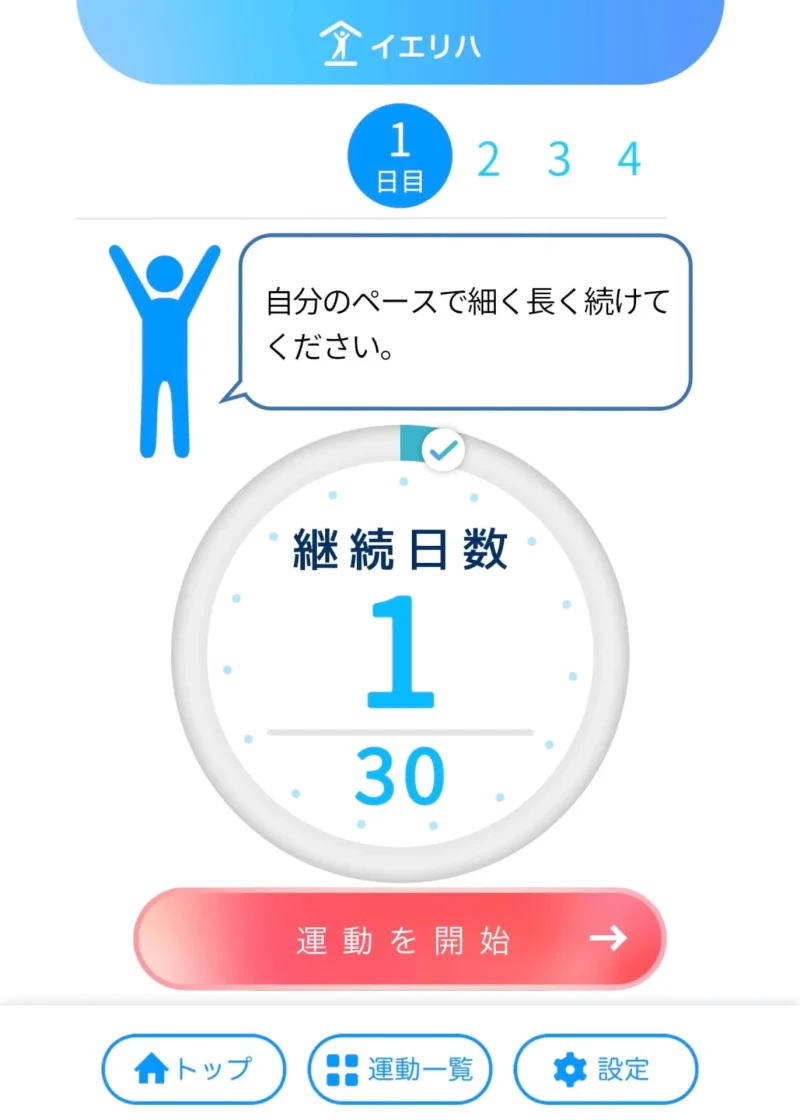
As you open the application and accomplishments are counted.
If there is an interval between days, the dates are added from the continuation.
Once I learn, I would like to make the most of my time by rehabilitating while doing something.
In particular, table wiping is a recommended rehabilitation that I would like to do every day because it cleans my desk (laughs).
Areas and types of rehabilitation menus
exercise
| Core Strength | Strengthen your body and walk straight. |
| Upper limb muscle strength | Bend firmly at the waist |
| Lower Limb Strength | Let’s go out with legs and feet strong! |
| Balance | It’s beautiful when it’s well balanced. |
| Physical strength | If it’s too tight, you can take a break. Please come back. |
activities of daily living
| Finger Movements | Finger movements are important in life. Let’s continue to do it little by little. |
| Squeezing movement | It is okay if you can’t do it well. Let’s try it slowly. |
| Wrist movements | It will help you to move smoothly when you pour a cup of tea or turn a doorknob. |
| Bending and extending the arms | It is easier to reach distant objects. |
oral care
| Mouth Cleaning | Brush your teeth and dentures to clean your mouth. Don’t forget to brush your tongue. |
| Moisturize your mouth | A well-wet mouth makes it easier to speak and eat. |
| Mouth and Swallowing Function | If you keep your mouth functioning, you will be able to eat a variety of foods and take in nutrients more easily. |
| Appetite | Moderate exercise will help keep you hungry. Hunger is the best food of all. |
nutrition
- Protein Content of Foods
- List of Nutritional Supplements
Exercise List
The application is illustrated with illustrations and videos.
Here is some textual information on what it looks like.
I’d like to get him mastered enough to eventually memorize the rehab menu!
core strength
- Place both elbows on knees (10 times)
- Place elbows on opposite knees (10 times each side alternately)
- Raise your hips and stop for 6 seconds (6 seconds x 5 times)
- Place both hands on the navel, stretch out as if thrusting forward, and put pressure on the abdomen (6 seconds x 5 times)
upper limb strength
- Shrug shoulders (20 times simultaneously on both sides)
- Raise hands in front of you (20 times simultaneously)
- Raise hands sideways (20 times simultaneously)
- Bend and stretch arms (20 times simultaneously)
- Gouper (20 times for both sides simultaneously)
lower limb muscle strength
- Thigh Raise (20 times each side alternately)
- Knee extension (20 times each side alternately)
- Toes and heels up (20 repetitions on each side simultaneously)
- Knee extension and leg open/close (20 times each side simultaneously)
- Raise buttocks and hold for 6 seconds (6 seconds x 5 times)
balance
- Reach forward (10 times with dominant hand)
- Reach sideways (10 times each side)
- Raise one hip (3 seconds x 5 times each side)
physical strength
- Wave your hands and stomp your feet (30 sec. x 2 times)
- Air ergo (30 sec. x 1 time)
- Standing up (as much as possible in 30 seconds)
Finger action
- Pinch the soybeans with your fingers and move them to the next side (15 grains x 2 back and forth)
- Pinch the selection scissors and remove when all are stopped at the edge of the box (15 pieces)
clasping action
- Cut along a straight line with scissors (8-10 pieces of A4 size paper)
- Grip a rubber ball (20 times)
Wrist movement
- Squeeze a dry towel (10 times)
- Turn over an empty plastic bottle or empty box and put it back (20 times)
Bending and stretching of arms
- Wipe the table with a towel (20 times)
- Fold and spread the towel twice (10 times)
Mouth cleaning
- (toothpaste) Tilt the tip of the bristles slightly in the opposite direction of the gum and place it on the border between the teeth and the gum, vibrate the bristles in a small motion as if pushing in slightly, and after the tip enters between the teeth, vibrate it from side to side until the tip does not come out between the teeth. 2 minutes (3 minutes if many leaves are left)
- (Denture brushing) 1-2 minutes under running water
- (Tongue brushing) Gently rub from back to front for 20 seconds. (Use a tongue brush or soft toothbrush)
Moisturizing the mouth
- (Parotid gland massage) Massage the lower part of the ear in a circular motion with all four fingers except the thumb. Then press forward so that saliva flows out of the ducts through which saliva passes. Repeat several times.
- (Submandibular gland massage) Press up from the back of the jaw to the front with the thumbs of both hands, shifting slightly. Repeat several times.
- (Sublingual Gland Massage) Press upward with both thumbs on the area under the chin. Repeat several times.
Mouth and Swallowing Function
- (Posture) Sit relaxed in a chair.
- (Deep breathing) Place your hands on your stomach and take a slow, deep breath.
- (Neck exercises) (1) Turn around slowly (2) Tilt your head slowly to the left or right so that your ears touch your shoulders (3) Turn your head slowly one time from side to side
- (Shoulder exercises) (1) Slowly raise both hands and roll them to the left and right (2) Slowly raise your shoulders and drop them (3) Rotate your shoulders twice from front to back and twice from back to front
- (Mouth exercises) (1) Repeat opening your mouth wide and chewing firmly (2) Squeeze and tighten your mouth to the side
- (Cheek exercises) Inflate and squish cheeks.
- (Tongue exercises) (1) Stick out the tongue (2) Pull the tongue toward the back of the throat (3) Lick both corners of the mouth (4) Touch the bridge of the nose and the tip of the chin
- (Cheek exercises) Repeat “pa-pi-p-p-e-po-pa-pa-ta-ca-la.
- (Coughing) Hold your stomach and cough.
- (Forehead exercises) Place your hand on your forehead and exert pressure as if pushing backward, and exert pressure as if tilting your head forward (exert pressure for 5 seconds and rest for 5 seconds 5-10 times)
appetite for food
- Extend knees (20 times each side alternately)
- Wave your hands and stomp your feet (30 sec. x 2 times)
- Air ergo (30 seconds x 1 time)
Interview with ST Taa “Rehab App”

Background of the interview
I myself use a wheelchair when I go out and it is very difficult for me to exercise standing up, so I asked if there was any application that would allow me to do rehabilitation while sitting at home.
As mentioned in his profile, Mr. Taa has a somewhat unusual background, from teacher to speech therapist, and the circumstances of his pursuit were obvious, and as I listened to his story, I was gradually struck by his heart.
This is because she was a wonderful person who even changed her career path and took on a completely different career, with the aspiration of providing “that experience of being moved by the rehabilitation that accompanies each life”.
We are also introduced as a sponsor in DisabilityLog’s profile!
Introduction to Rehab Rehabilitation Apps for Speech-Language Pathologists
Mr. Taa himself, while working as a speech-language pathologist, has felt that ST training is in some ways analog. Therefore, she has been thinking, “If we add digital elements, it would reduce the time spent preparing things and make rehabilitation more enjoyable for patients,” “I want STs to provide rehabilitation that patients can enjoy,” “If there are effective teaching materials and apps for rehabilitation that become mannerisms and give a sense of being forced to do things, it would be fun with direction. I think that games might be able to change the way children think and perceive things while having fun,” and started introducing “apps” on his blog.
The main focus is on introducing applications and rehabilitation methods that can be used for rehabilitation based on the knowledge of specialized therapists for STs, but recently they have been focusing on “launching educational materials” for STs to support STs.
The three areas of expertise are
- Higher brain dysfunction…difficulty in thinking
- Swallowing disorder…difficulty in swallowing and eating
- Dysarthria…difficulty in speaking
If you are interested, especially if you are an ST, please take a look at the Rehab Application.

Rehab App Recommendations
Among the many articles, we were also asked to recommend some articles for the non-specialist layperson.
To children with developmental disabilities, we pick up two carefully selected articles introduced for parents.
Discussion of the effectiveness of the “Think Think” educational app based on interviews and papers.

For children with developmental disabilities] First month free! Now’s the time to try Wonderbox!

Cute characters in the rehearsal application
A humanoid character that has appeared several times in callouts in articles in the Reha application and in images on the website. The normal type is Reha-kun, a boy. The one with the red ribbon is a girl and she is an apurin. They have various facial expressions, rich emotions, and the hand-drawn feel is also very friendly! The illustrations are so cute and curious that we asked about these two characters.
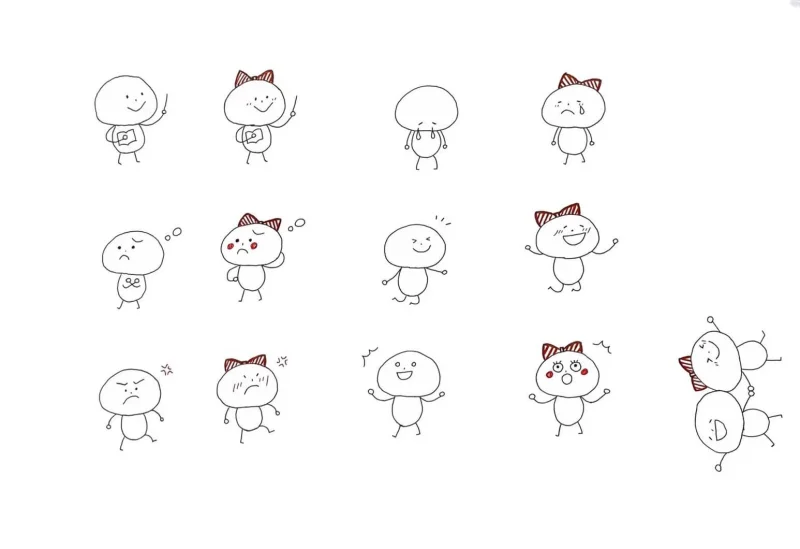
By the way, the illustration creator is his wife…! She was very pleased when I praised it. I’m hoping for a wheelchair version too! I hope we can meet somewhere someday!

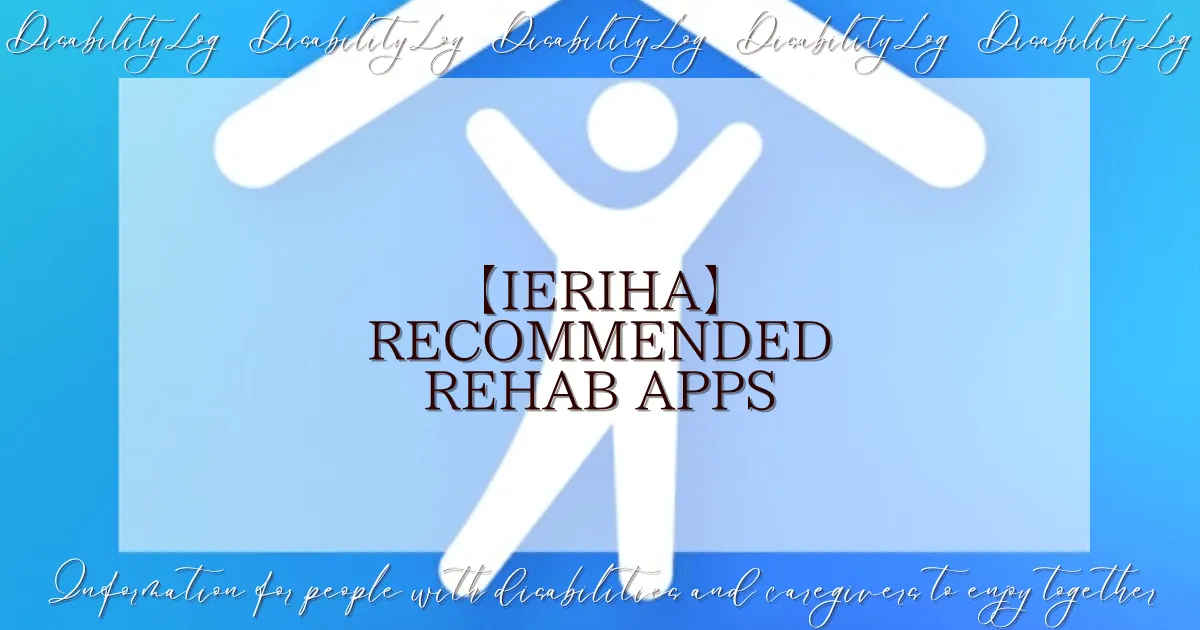













コメント